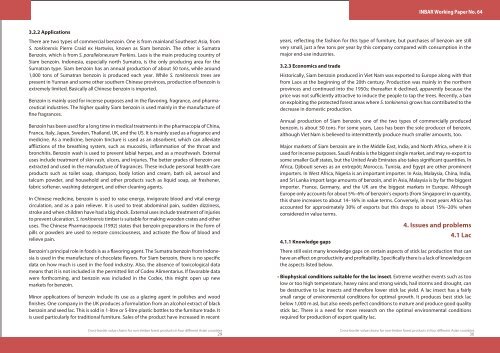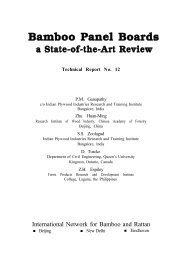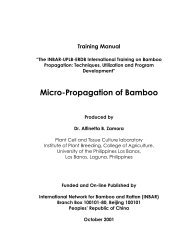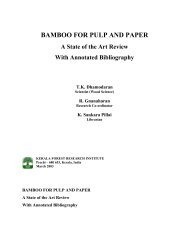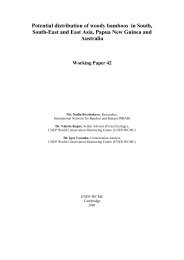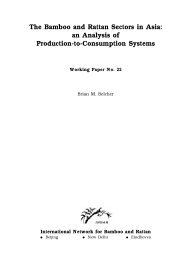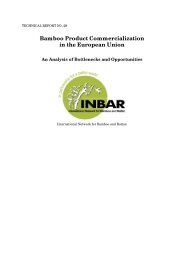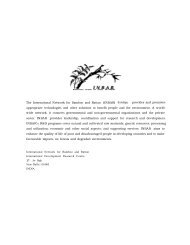Cross-border NTFP value chains - International Network for Bamboo ...
Cross-border NTFP value chains - International Network for Bamboo ...
Cross-border NTFP value chains - International Network for Bamboo ...
You also want an ePaper? Increase the reach of your titles
YUMPU automatically turns print PDFs into web optimized ePapers that Google loves.
3.2.2 Applications<br />
There are two types of commercial benzoin. One is from mainland Southeast Asia, from<br />
S. tonkinensis Pierre Craid ex Hartwiss, known as Siam benzoin. The other is Sumatra<br />
Benzoin, which is from S. paralleloneurum Perkins. Laos is the main producing country of<br />
Siam benzoin. Indonesia, especially north Sumatra, is the only producing area <strong>for</strong> the<br />
Sumatran type. Siam benzoin has an annual production of about 50 tons, while around<br />
1,000 tons of Sumatran benzoin is produced each year. While S. tonkinensis trees are<br />
present in Yunnan and some other southern Chinese provinces, production of benzoin is<br />
extremely limited. Basically all Chinese benzoin is imported.<br />
Benzoin is mainly used <strong>for</strong> incense purposes and in the avoring, fragrance, and pharmaceutical<br />
industries. The higher quality Siam benzoin is used mainly in the manufacture of<br />
ne fragrances.<br />
Benzoin has been used <strong>for</strong> a long time in medical treatments in the pharmacopia of China,<br />
France, Italy, Japan, Sweden, Thailand, UK, and the US. It is mainly used as a fragrance and<br />
medicine. As a medicine, benzoin tincture is used as an absorbent, which can alleviate<br />
aictions of the breathing system, such as mucositis, inammation of the throat and<br />
bronchitis. Benzoin wash is used to prevent labial herpes, and as a mouthwash. External<br />
uses include treatment of skin rash, ulcers, and injuries. The better grades of benzoin are<br />
extracted and used in the manufacture of fragrances. These include personal health-care<br />
products such as toilet soap, shampoo, body lotion and cream, bath oil, aerosol and<br />
talcum powder, and household and other products such as liquid soap, air freshener,<br />
fabric softener, washing detergent, and other cleaning agents.<br />
In Chinese medicine, benzoin is used to raise energy, invigorate blood and vital energy<br />
circulation, and as a pain reliever. It is used to treat abdominal pain, sudden dizziness,<br />
stroke and when children have had a big shock. External uses include treatment of injuries<br />
to prevent ulceration. S. tonkinensis timber is suitable <strong>for</strong> making wooden crates and other<br />
uses. The Chinese Pharmacopoeia (1992) states that benzoin preparations in the <strong>for</strong>m of<br />
pills or powders are used to restore consciousness, and activate the ow of blood and<br />
relieve pain.<br />
Benzoin’s principal role in foods is as a avoring agent. The Sumatra benzoin from Indonesia<br />
is used in the manufacture of chocolate avors. For Siam benzoin, there is no specic<br />
data on how much is used in the food industry. Also, the absence of toxicological data<br />
means that it is not included in the permitted list of Codex Alimentarius. If favorable data<br />
were <strong>for</strong>thcoming, and benzoin was included in the Codex, this might open up new<br />
markets <strong>for</strong> benzoin.<br />
Minor applications of benzoin include its use as a glazing agent in polishes and wood<br />
nishes. One company in the UK produces a <strong>for</strong>mulation from an alcohol extract of black<br />
benzoin and seed lac. This is sold in 1-litre or 5-litre plastic bottles to the furniture trade. It<br />
is used particularly <strong>for</strong> traditional furniture. Sales of the product have increased in recent<br />
<strong>Cross</strong>-<strong>border</strong> <strong>value</strong> <strong>chains</strong> <strong>for</strong> non-timber <strong>for</strong>est products in four dierent Asian countries<br />
29<br />
INBAR Working Paper No. 64<br />
years, reecting the fashion <strong>for</strong> this type of furniture, but purchases of benzoin are still<br />
very small, just a few tons per year by this company compared with consumption in the<br />
major end-use industries.<br />
3.2.3 Economics and trade<br />
Historically, Siam benzoin produced in Viet Nam was exported to Europe along with that<br />
from Laos at the beginning of the 20th century. Production was mainly in the northern<br />
provinces and continued into the 1950s; thereafter it declined, apparently because the<br />
price was not suciently attractive to induce the people to tap the trees. Recently, a ban<br />
on exploiting the protected <strong>for</strong>est areas where S. tonkinensis grows has contributed to the<br />
decrease in domestic production.<br />
Annual production of Siam benzoin, one of the two types of commercially produced<br />
benzoin, is about 50 tons. For some years, Laos has been the sole producer of benzoin,<br />
although Viet Nam is believed to intermittently produce much smaller amounts, too.<br />
Major markets of Siam benzoin are in the Middle East, India, and North Africa, where it is<br />
used <strong>for</strong> incense purposes. Saudi Arabia is the biggest single market, and may re-export to<br />
some smaller Gulf states, but the United Arab Emirates also takes signicant quantities. In<br />
Africa, Djibouti serves as an entrepôt; Morocco, Tunisia, and Egypt are other prominent<br />
importers. In West Africa, Nigeria is an important importer. In Asia, Malaysia, China, India,<br />
and Sri Lanka import large amounts of benzoin, and in Asia, Malaysia is by far the biggest<br />
importer. France, Germany, and the UK are the biggest markets in Europe. Although<br />
Europe only accounts <strong>for</strong> about 5%–6% of benzoin’s exports (from Singapore) in quantity,<br />
this share increases to about 14–16% in <strong>value</strong> terms. Conversely, in most years Africa has<br />
accounted <strong>for</strong> approximately 30% of exports but this drops to about 15%–20% when<br />
considered in <strong>value</strong> terms.<br />
4. Issues and problems<br />
4.1 Lac<br />
4.1.1 Knowledge gaps<br />
There still exist many knowledge gaps on certain aspects of stick lac production that can<br />
have an eect on productivity and protability. Specically there is a lack of knowledge on<br />
the aspects listed below.<br />
• Biophysical conditions suitable <strong>for</strong> the lac insect. Extreme weather events such as too<br />
low or too high temperature, heavy rains and strong winds, hail storms and drought, can<br />
be destructive to lac insects and there<strong>for</strong>e lower stick lac yield. A lac insect has a fairly<br />
small range of environmental conditions <strong>for</strong> optimal growth. It produces best stick lac<br />
below 1,000 m asl, but also needs perfect conditions to mature and produce good quality<br />
stick lac. There is a need <strong>for</strong> more research on the optimal environmental conditions<br />
required <strong>for</strong> production of export quality lac.<br />
<strong>Cross</strong>-<strong>border</strong> <strong>value</strong> <strong>chains</strong> <strong>for</strong> non-timber <strong>for</strong>est products in four dierent Asian countries<br />
30


